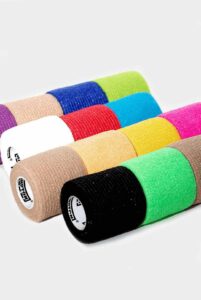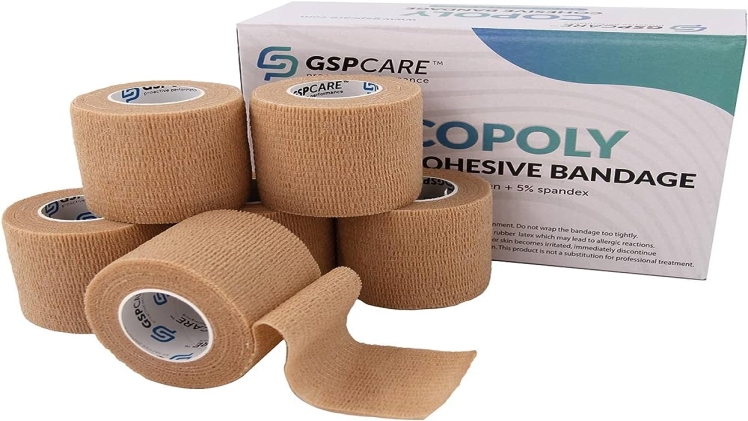
It’s pretty impressive how little thought goes into the importance of self-adherent bandages. They have been part of our cultural consciousness to the extent that it is hard to imagine a world where dressing and tapes were not part of medical kits worldwide. In fact, before modern dressing, when burns, cuts, or more severe wounds were endured, the dressing would have to be clean clothes tied in knots. And speaking honestly, before the discovery of bacteria and possible infection from contact, it was common to reuse dirty dressings.
Thankfully we have come a long way since then and now dressing bandages are safer to use and honestly require more thought than simply pressing a cloth against the open wound. These leaps and bounds in technology significantly impacted the infection rate and how quickly patients recover from injuries post-surgery.
In order to prevent the body’s natural healing process from being interfered with, the adhesive bandage shields the wound and scab from dirt, injury, and bacteria. Acrylic polymers are frequently utilized as adhesives in bandages.
Using self-adherent cohesive bandages is the next step in the evolution of medicine, not only sports medicine. At the same time, self-adherent bandages in medicine are used to hold dressings in place to protect wounds or burns. Sports medicine uses these self-adherent bandages to hold ice, warm towels, and objects against the skin to help heal a hurt articulation or tweaked joint.
This article will explore the history of the bandage and five crucial facts about the new generation of self-adherent bandages and what they are popularly used for. It will also include a short list of differences between the newer elastic sports and traditional surgical tape.
5 Key Facts About Self-Adherent Cohesive Bandages: What Are These Bandages?
Medical dressings, known as adherent and cohesive bandages, are created to be secured in place by the non-woven material’s inherent elasticity without the need for tape or adhesives. They are employed in various medical specialties, such as orthopedics, general wound care, and burn management. Given their frequent occurrence in hospitals and clinics, it’s critical to understand how they operate and how they affect patient outcomes.
Both patients and physicians require access to high-quality self-adherent cohesive bandages in order to be able to treat wounds and injuries quickly. These are perfect for various wounds, including cuts, scrapes, burns, and blisters, because they can be applied directly to the affected region without clinging to the skin. They can also be used as an efficient wound dressing on hard-to-reach places like the groin or armpits for those with back difficulties. It’s crucial to understand what makes these bandages different from others if you’ve never used them before.
Adhesive tape first appeared in 1845. A new product called Surgical Tape was created by surgeon Dr. Horace Day using strips of fabric and a rubber adhesive. The Band-Aid was created in 1921 by Earle Dickson. After cutting his wife’s fingers in the kitchen with the surgical strips he had invented, Horace Day glued a piece of gauze to some cloth-backed tape and covered it with crinoline. He received a V.P. title from Johnson and Johnson for his services.
Modern bandages are made from various components depending on their intended use. The surgical tape has a more robust composition, so it does not provide much elasticity since it holds the dressing in place. While other tapes intended to go over the wounds may have a little cotton mixture to provide breathability while protecting the area. The main feature most, if not all, have in common is their adhesive is made up of natural rubber latex.
5 Key Facts About Self-Adherent Cohesive Bandages: The Next Generation.
Recently in the 1970s, a new sports self-adherent bandage was created in Japan by Dr. Kenzo Kase. The chiropractor created an elastic variation to the traditional surgical tape. The need to introduce to the market a tape that could allow athletes to train while lightly injured inspired the doctor to not only create a tape but was inspired to come up with an entire treatment to accompany his creation to best help sports enthusiasts heal quickly and return to their primary passion.
The main difference between classical surgical tape and K-Tape is the elasticity of K-Tape. It is designed to allow movement while still being rigid enough to help support muscles during training. The combination of nylon and cotton fabric allows for freedom of movement while still helping keep the sports practitioner stable.
Dr. Kase’s tape also stands out with the clever use of adhesive. Its primary intention is to stick to the skin for close to five days. The adhesive in his brand K-Tape has a non-steroidal and anti-inflammatory linament that helps fight off inflammation. While other brands of kinesiology tape also include topical medication such as camphor or menthol.
Kinesiology tapes’ main goal is to help fight off inflammation. It does so by applying pressure to a specific point on the skin, pulling and creating space so blood can flow freely. The more blood, the more oxygen reaches the area the faster the person heals. It also prevents the accumulation of inflammatory cells that can lead to swelling and soreness.
Dr. Kase’s tape became famous after it was widely featured in the 2012 Olympics, as several prominent athletes wore the colorful tape to help the sports teams perform to the best of their abilities.
While both tapes are used in the medical field especially sports medicine, K-tape is not designed for emergency treatments. The composition would do little to stop blood loss since it cannot help keep a wound close due to the tape’s elasticity. The powerful adhesive might even cause the wound it is protecting to re-open, as it is notoriously difficult to remove.
5 Key Facts About Self-Adherent Cohesive Bandages: When to Use the Tapes
For a wide range of ailments, cohesive bandages are a fantastic option. There are advantages and disadvantages to both self-adherent and non-self-adherent cohesive bandages. Cohesive bandages are a better choice if you’re searching for enhanced wound care because they have more elasticity and can provide more compression. For optimum results, experiment with both approaches in various contexts.
You can use cohesive choices for tiny wounds with less bleeding; for more significant wounds that need more compression, you should use regular tapes. Additionally, cohesive bandages might be worth considering as an alternative choice—or perhaps an improvement from your existing routine—if you have sensitive skin or are allergic to latex or other components used in most adhesive bandages.
Athletic tape or Kinesiology sports tape should be used for sports lesions that do not include lacerations or open wounds. There is a fixed pattern and a specific way to cut the tape when applied. These patterns are intended to support the individual, and specific cuts are intended to support the tape and act as an anchor.
- I-Shape: Simple cut along the width of the tape to create a length appropriate to the area being treated
- Y-Shape: Cut at the end of the tape, creating a Y shape.
- X-Shape: Cut at the length of both ends to crate and X Shape.
- Fan Shape: Multiple cuts at one end to provide support to several muscle groups.
- O-Shape: Cut along the middle while leaving the ends intact to create an almost doughnut-shaped length of tape.
5 Key Facts About Self-Adherent Cohesive Bandages: Can I Reuse the Tapes?
Despite being a frequent practice, medical professionals advise against repeatedly using cohesive or self-adhering bandages. Both kinds of bandages have an acrylic adhesive coating on top that attaches to itself rather than your skin. But the more you use them, the less effective the glue is.
If a bandage slips while being applied, you are far more likely to get cut or hurt after its ability to adhere tightly to your skin is lost. Store cohesive and self-adherent bandages away from excessive heat, even if they haven’t been used yet. Temperature changes prematurely harm both types of adhesives used in these goods.
The same applies to K-Tape; it is a single-use policy, while you may leave it on for an extended period of time and up to 5 days. The tape is not intended for removal and reapplication as the adhesive will lose grip and become less effective at protecting and supporting.
5 Key Facts About Self-Adherent Cohesive Bandages: So How Long Do They Last?
Any form of medical or wound care product must be of enduring quality. The mere act of wrapping a bandage over a part of your body is unlikely to cause it to wear out; instead, bandages can endure for days or weeks, depending on how frequently you use them and where you apply them.
If your wound is damp or unclean, it will be crucial to change your dressing every day or two to prevent infection. Even if your bandage is clean and showing no signs of infection, replacing it is always a good idea because it is always better to be safe than sorry. That said, cohesive bandages are difficult to maintain and last longer.

